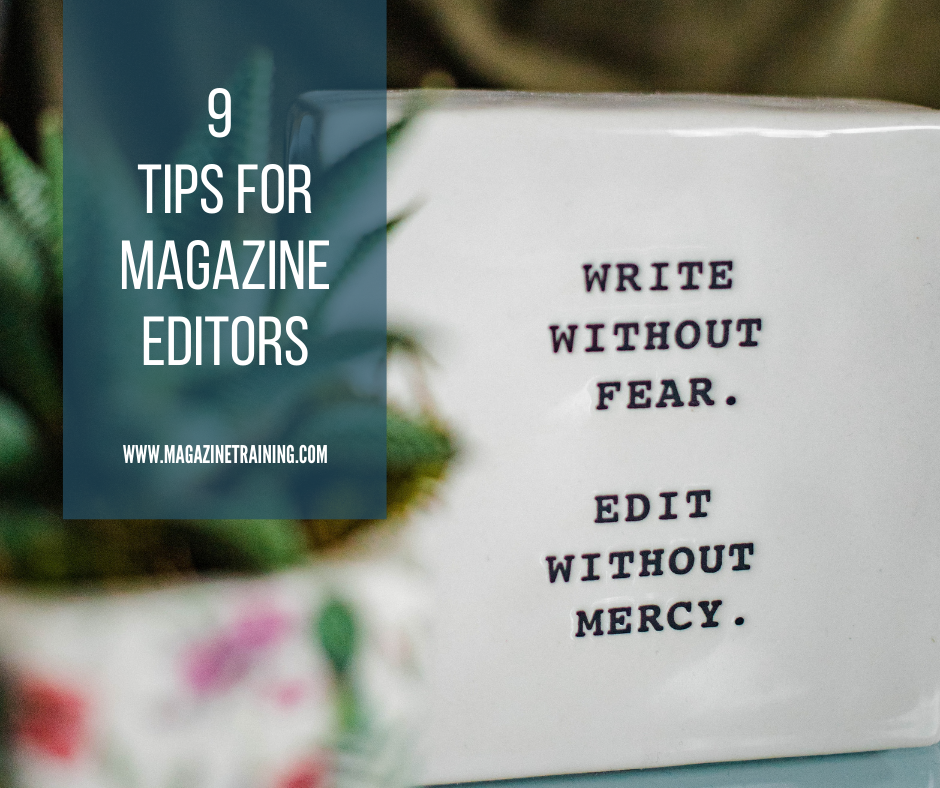
These editing tips will help magazine editors to tighten up both their own writing and the writing of those they’re editing. Especially these days, the global magazine publishing industry has had a 4.9% decrease in annual growth between 2012 and 2017 due to competition from online magazines. This has made it more important than ever that every word counts, and magazine editors are at the top of their game.
Here are 9 editing tips for magazine editors:
1. Remove Weak Descriptions
You’ll often find weak descriptions in the form of bad adjectives. They’re like leeches that suck the life from your writing. And they often go hand-in-hand with adverbs, making them easy to spot. Here are some examples:
- Very big = Huge
- Really bad = Terrible
- Very beautiful = Gorgeous
You get the idea.
Even if you don’t have an adverb pointing to a weak adjective, you can often make your writing more impactful by finding stronger alternatives:
- Scared = Terrified
- Dirty = Filthy
- Tired = Exhausted
2. Keep it Simple
Long sentences often lose the reader. They sometimes contain more than one idea, meaning readers lose their focus because they don’t get a break. While there is a time and a place for comma-heavy sentences, you’ll notice that articles are much easier to read when sentences are shorter.
Cut longer sentences in two and focus on simplicity.
3. Focus on Micro-Edits
It’s amazing how the smallest edits can have a huge impact on the readability of an article. And these small edits quickly add up. Here are a few micro-edits to focus on so that your sentences are clearer and tighter:
Redundancy and Wordiness
Another editing tips for magazine editor is to remove phrases, words, and whole sentences. This can be as small as “the fact that” or “in order to.”
It could also be “the surfboard is long in size” (in size is unnecessary).
Create Paragraphs
Many first drafts will have a bunch of paragraphs without a focus. When each sentence has a different topic, it’s difficult for a reader to follow along. Make sure that all of the sentences in each paragraph relate to the point of that paragraph.
Check Verb Tenses
This is a common problem for many writers. One second they’re writing in the past tense, and the next they’ve switched to the present. Often the past tense will work best, but make sure that it’s consistent all the way through.
4. Remove Jargon
If your magazine is catering to a specific audience that understands a particular type of jargon, have at it. But there’s no need to use jargon for the sake of it.
Some writers may believe that using a particular type of jargon makes them sound smart. As an editor, you know better. Readers have short attention spans. Great writing makes it easy for readers and encourages them to keep reading. If they need to look up a word, that word usually shouldn’t be included.
The English language has more than enough words to get your point across. Check a thesaurus for a more common or shorter word if you need to swap.
5. Consider Formatting
Formatting makes a massive difference to the overall readability of an article. As an editor, you’ll be on the lookout for the following:
Missing Quote Marks
Sometimes writers forget to close their quotes with the second quotation mark. It’s also a good idea to check if they have placed the period outside or inside that quote mark. We’re usually taught to place it outside, but it’s now expected to see it inside the quote mark- even if the original quotation didn’t include a period.
Use Headings Liberally
Headings help break the page up and make it much easier for readers. Both headings and subheadings are essential for assisting readers to know where they are.
Remove Double Spacing
Some writers (mostly older writers) use two spaces after a period. This is because writers were taught to write this way when using typewriters and many continued even when using computers.
by Andina Kanti, MagLoft
Photo by hannah grace on Unsplash
Related posts
Magazine Training International’s mission is to encourage, strengthen, and provide training and resources to Christian magazine publishers as they seek to build the church and reach their societies for Christ.

